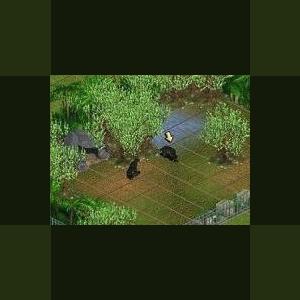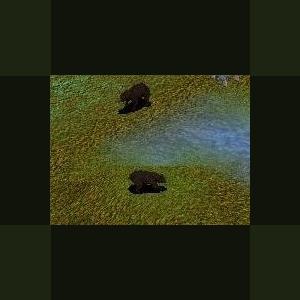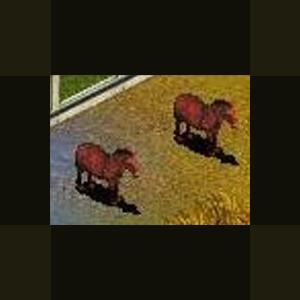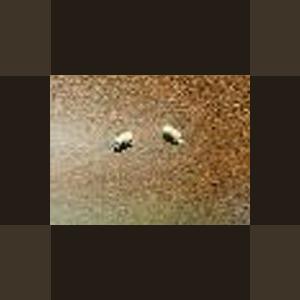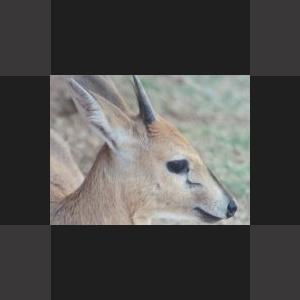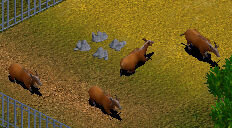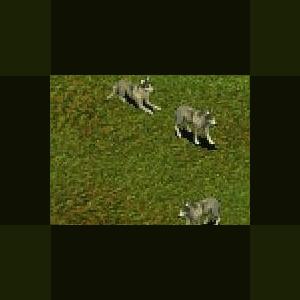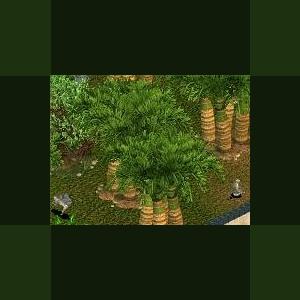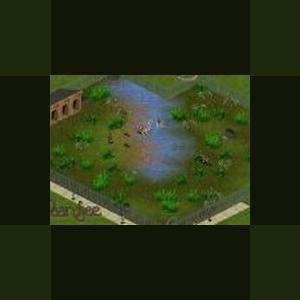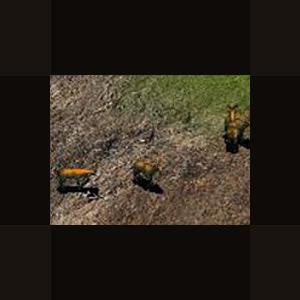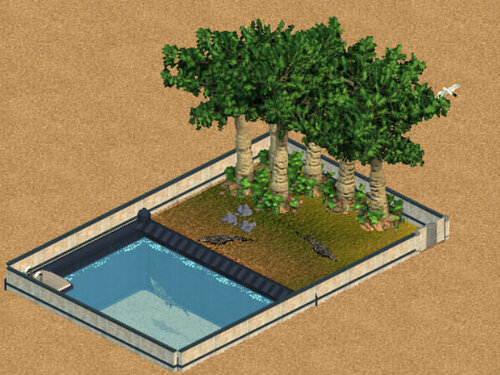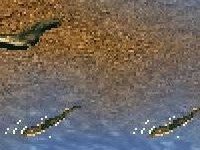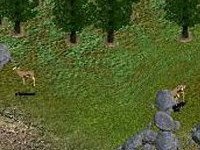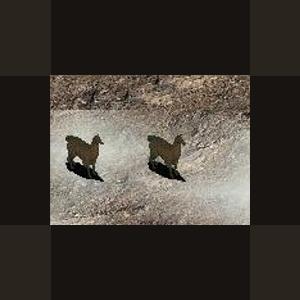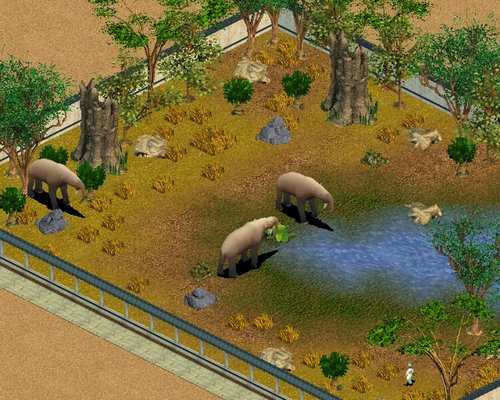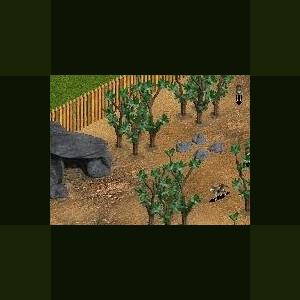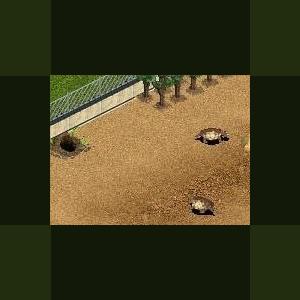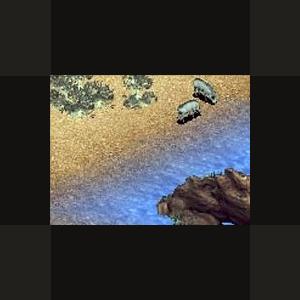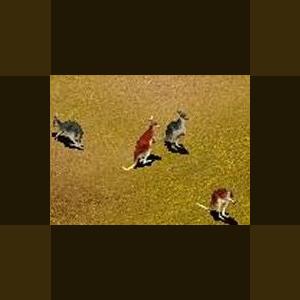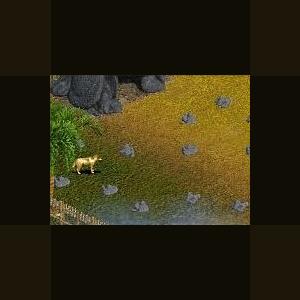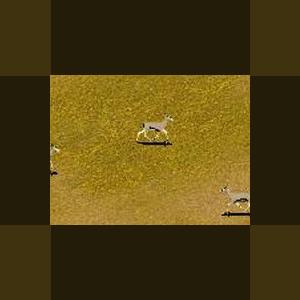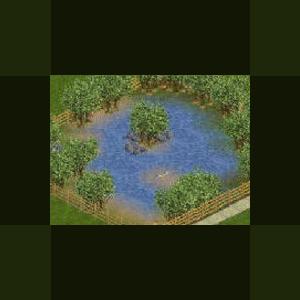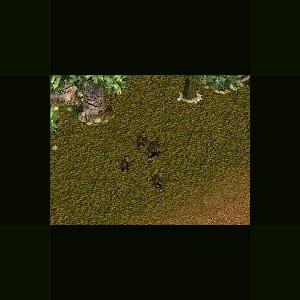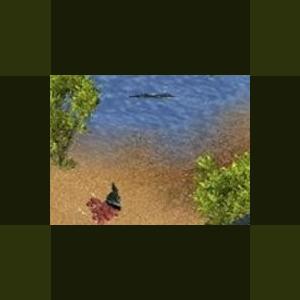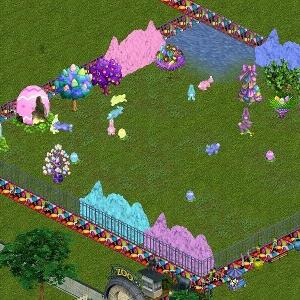280 files
-
Cigau by Jordan and Genkicoll
By Guest
The Cigau is a Sumatran mystery wild cat described as a cross between a lion and a tiger. Described as being slightly smaller, but apparently more heavily built, than the Sumatran tiger, they are greatly feared by the hunters of Kerinci--the only animal to produce such a reaction. They claimed the cigau attacks without provocation. "Cigau hates man".
Animal recolor and programming by Jordan, stat change and research by genkicoll.
Updated 2010-10-30
Just to save space with less in zip and smaller image.
Nothing new.
302 downloads
0 comments
Updated
-
Cinnamon Bear by Ghirin
By Guest
A beautiful color phase of the black bear that will look great in any zoo.
Cinnamon bears prefer to live alone or in small groups.
Cinnamon bears like to sleep in rock caves.
Updated 2010-10-30
Just to save space with less in zip and smaller image.
Nothing new.
260 downloads
0 comments
Updated
-
Cleveland Bay Horse by Sundance
By Guest
Cleveland Bay Horse by Sundance
A beautiful horse by Sundance. Made with help from Jay. Thank you, Jay!
Updated 2010-10-30
Just to save space with less in zip and smaller image.
Nothing new.
282 downloads
0 comments
Updated
-
Collared Lemming by Ghirin
By Guest
The collared lemming (varying lemming, genus Dicrostonyx) is a stout-bodied rodent native to the tundra regions of the northern hemisphere. The fur of lemmmings of this genus change color between seasons, from dark in summer to white in winter, making this the only rodent in the world with a coat that changes to white in the winter. The collared lemming also develops a double claw during the winter to aid it in digging through snow and ice during the winter.
Collared lemmings dig and dwell in burrows, using the tundra sod and snow as digging substrate. Their burrows can reach up to 6 m in length and be 20 cm wode. A nest burrow is usually found at the end of the tunnel.
Collared lemmings live in treeless tundra and are active year-round. In the wild, they eat grass, flowers, fruit, sedeges, and bush stems.
These lemmings are prolific and surges in local populations have been recorded followed by “crashes”.
Created by Ghirin 2003
Updated 2010-10-30
Just to save space with less in zip and smaller image.
Nothing new.
348 downloads
0 comments
Updated
-
Common Duiker by Jordan
By Guest
Body Length: 80-115 cm / 2.6-3.8 ft.
Shoulder Height: 45-60 cm / 1.5-2 ft.
Tail Length: 10-20 cm / 4-8 in.
Weight: 10-20 kg / 22-44 lb.
The coat is generally pale reddish-brown to grizzled gray, depending on the geographical location. The undersides are whitish, while the muzzle, nose bridge, and forelegs are black. The short tail is black on the top, contrasting sharply with the fluffy white underside. The long, pointed ears are separated by a tuft of hair on the forehead. Females are usually larger than males. The sharply pointed horns are usually found only in males and grow 7-18 cm / 3-7 inches long. The horns are more vertically oriented than in other duiker species, due to the more open habitat.
Gestation Period: 6-7 months.
Young per Birth: 1
Weaning: 2 months.
Sexual Maturity: Females at 8-10 months, males at 12 months.
Life span: Up to 14 years.
After birth, the young lie up in dense cover for a number of weeks.
Feeding predominantly from dusk until dawn, the gray duiker rests in favourite hiding places in scrub or grass during the day. This small antelope has exceptional speed and stamina, and is usually able to outrun dogs that chase after it. The home ranges of individuals of the same sex rarely overlap. However, there is substantial common land in the ranges of individuals of the opposite sexes. Males are territorial, marking their defended areas with preorbital secretions and attacking other males that intrude. The favourite resting place of these males is a high spot overlooking their territory. In favourable areas there are approximately 2 animals per square kilometer. Juveniles make a loud bleat if caught, which brings the parents running.
Family group: Usually solitary, although pairs are occasionally sighted.
Diet: Tree and bush foliage, fruits, seeds, occasionally carrion.
Created by Jordan, Zoo Tek Designer, 2005
Inspired by the Zoo Tycoon Brains Trust at Zoo Tek
Updated 2010-10-30
Just to save space with less in zip and smaller image.
Nothing new.
385 downloads
0 comments
Updated
-
Congo Buffalo
By Khaydar
Adopt a Congo Buffalo (Syncerus caffer nanus) for your zoos
Congo Buffalo description:
Minimum happiness needed for chance of breeding: 90.
Liked foliage:
Elephant Ear Tree
Liked rock:
Large Rock, Small Rock - Medium, Small Rock - Small, Rainforest Rock
Stone Ruins
Animal can jump.
Number of animals allowed per exhibit: 3-15 with 20 squares each.
A suitable exhibit for 3 of this animal has 60 squares containing terrain of:
24 Rainforest Floor, 6 Dirt, 18 Savannah Grass, 12 Fresh Water
using 7 Elephant Ear Tree most liked plant
and using 5 Small Rock - Small most liked rock.
Preferred shelter: Large Stable.
Credits to DutchDesigns for the model and mesh
Made by khaydar
258 downloads
- living animal
- bovid
- (and 1 more)
0 comments
Updated
-
Coyote by LAwebTek
By Guest
Coyote
Author: LAwebTek
The name coyote is a Spanish alteration of the original Aztec name coyotl. The Latin name Canis latrans, meaning barking dog, was given to it by Thomas Say, who published a description of the species in 1833. Since 1967, its official name in Canada, in both English and French, has been coyote. In some parts of Canada coyotes are called "brush wolves." Wolves are much larger and characteristically hunt in packs.
Slimmer and smaller than the wolf, the male coyote weighs from 9 to 23 kg, has an overall length of 120–150 cm (including a 30–40 cm tail), and stands 58–66 cm high at the shoulder. The female is usually four-fifths as large.
The coyote's ears are wide, pointed, and erect. It has a tapering muzzle and a black nose. Unlike most dogs, the top of the muzzle on coyotes forms an almost continuous line with the forehead. The yellow, slightly slanting eyes, with their black round pupils, give the coyote a characteristic expression of cunning. The canine teeth are remarkably long and can inflict serious wounds. The neck is well furred and looks oversized for the body. The long tongue often hangs down between the teeth; the coyote regulates its body temperature by panting.
The paw, more elongated than that of a dog the same size, has four toes with nonretractable claws. The forepaws show a rudimentary thumb, reduced to a claw, located high on the inner side. The claws are not used in attack or defence; they are typically blunted from constant contact with the ground and do not leave deep marks.
The fur is generally a tawny grey, darker on the hind part of the back where the black-tipped hair becomes wavy. Legs, paws, muzzle, and the back of the ears are more yellowish in colour; the throat, belly, and the inside of the ears are whiter. The tail, darker on top and lighter on the underside, is lightly fawn-coloured towards the tip, which is black.
The coyote's fur is long and soft and well suited to protect it from the cold. Because it is light-coloured in winter and dark in summer, it blends in well with the seasonal surroundings.
Like all Canidae, the coyote has, at the root of the tail, a gland that releases a scent. Such glands also exist on other parts of the body. Scent glands often become more active when the animals meet. The coyote's urine has a very strong smell and is used to mark out its territory. Trappers use the secretions when they set traps to attract the coyote.
European settlers found the coyote on the plains, prairies, and deserts of central and western North America. It appeared to prefer open or semi-wooded habitats. However, about the turn of the century, the coyote began a dramatic range expansion that is still in progress.
In Canada, the coyote still inhabits its traditional habitats, the aspen parkland and short- and mixed-grass prairie in the three prairie provinces. However, it has spread north into the boreal forest, west into the mountains, and east into Ontario, Quebec, and the Atlantic provinces. The progress of this dramatic "invasion" has been carefully charted; for example, coyotes established themselves in Ontario about the turn of the century, in Quebec in the 1940s, and in New Brunswick and Nova Scotia in the 1970s. Most astonishing of all, coyotes have recently been discovered in western Newfoundland, apparently having crossed on the ice from Nova Scotia.
The reasons for the coyote's expansion are not fully understood but probably include several conditions created by people: the clearing of forests, provision of carrion from domestic livestock, and the removal of the wolf. The mosaic of grassy fields, brush, and woodlots created by farming areas once covered with unbroken forest has provided attractive habitat for the coyote, as well as several other species like the red fox and raccoon. The coyote has learned to scavenge the carcasses of domestic livestock, much as it still scavenges the carrion left by wolves, where the two species occur together. The removal of the wolf in some areas has meant more to coyotes than the absence of a feared predator. It has meant less competition for many prey animals. For example, in winter, when snow conditions are right, coyotes can themselves kill large ungulates (hoofed mammals), such as deer, that multiply in the absence of wolves. Also, in hard winters, these swollen deer populations run out of food, the deer die of starvation, and the resident coyotes enjoy a food bonanza.
Like the wolf, the coyote's best known trait is its yelping and howling cry, a sequence of high-pitched, ear-piercing bayings. The coyote can also bark, growl, wail, and squeal. Although often silent in daytime, it may make itself heard at any time from sunset to sunrise, and especially at dusk and dawn.
Should there happen to be several coyotes in the same vicinity, the howling of one triggers that of the others, resulting in an impressive concert. Two coyotes howling in unison can create the illusion of a dozen or more. The coyote can also sound farther away than it is.
Scientists are intrigued by the coyote's howling, which seems to be a means of communication. The cry invariably brings a reply, then a sort of commentary followed by another prolonged cry, and finally a volley of raucous yelpings. Is it a cry for food, for a mate, or a proclamation of its territorial claims? Is it just an expression of joy at being alive or of sociability? The coyote is fond of playing with other coyotes, even with its prey before devouring it.
The coyote's senses of hearing and smell are so well developed that a sudden odour or noise can make it change its course in mid-step. Its agility in this respect is incredible, perhaps unique in the animal kingdom.
The coyote is a remarkably hard runner, galloping along at 40km per hour, but capable of reaching 64km per hour. Greyhounds, well known for their speed in running, can catch up with coyotes, but may require quite a long time to do so. Should the need arise, the coyote can swim well.
Coyotes appear to be monogamous, and couples may remain together for several years. Both sexes can breed at one year of age under good conditions, although both sexes usually breed somewhat later in life. During the mating season, males solicit the females' favours. The mating takes place mainly during February-March; gestation lasts from 60 to 63 days.
The coyote uses a den for the birth and early care of its cubs. It may be located at the base of a hollow tree or in a hole between rocks, but most often consists of a burrow in the soil. The coyote prefers to den on the banks of a stream or the slopes of a gorge and usually chooses a concealed spot. It often enlarges an abandoned marmot or badger burrow. The female may prepare alternative lodgings to enable her family to move to another refuge should trouble occur. Earth, pushed toward the entrance, is piled up onto a fan-shaped heap, which the animal skirts when going in or out. The same shelter may be used for several years.
Before the female gives birth, or "whelps," the den is thoroughly cleaned. On average, she bears three to seven pups, covered with fine brown fur, whose eyes remain closed for the first eight or nine days.
The male prowls around and brings food to the entrance as long as the pups do not venture from the den. The adults remove refuse as it accumulates. Weaning begins about one month after birth; thereafter the adults regurgitate half-digested food for the pups.
At about three weeks of age, the pups begin to romp around under the adults' watchful supervision, first inside the shelter, then outside. Should some enemy come too close, the adult utters a special warning bark, then lures the enemy away.
Later, the adults teach the pups how to hunt. When fall comes, the young coyotes may leave their parents to claim their own territory. If there is an abundant food supply, pups may stay with the adults to form packs, or clans.
Although primarily a flesh-eater, the coyote will eat just about anything available. Rabbits and hares are typically dietary staples, as are small rodents. Blueberries and other wild fruits are commonly eaten, in quantity, in summer and fall. Coyotes also eat insects, for example, grasshoppers, when they become available. Where coyotes and wolves live near each other, coyotes scavenge from wolf kills. Carrion from livestock and other sources is important too, especially in winter. Coyotes commonly prey on deer fawns in spring and summer; however, they may also prey on adult-sized deer and other large hoofed mammals during certain snow conditions in winter. Coyotes prey on domestic sheep when they are available, and may take beef calves and domestic poultry, too.
Coyotes have flexible social behaviour and adjust their hunting methods to the prey size and food sources available. Coyotes often hunt small prey animals singly, whereas they hunt large prey and defend large carcasses in groups.
The coyote has numerous foes. Chief among these are people; in some areas, 90% of the deaths of coyotes older than five months are caused by people, whether purposefully with guns, poison, and traps, or accidentally with vehicles and farm machinery. Wolves, black bears, mountain lions, and eagles all prey on the coyote. A Iynx can kill a coyote but will not attempt to do so unless the odds are in its favour.
Parasites and diseases can sometimes lead to death. Common are outbreaks of sarcoptic mange, an infestation by microscopic mites that causes thickening of the skin, loss of hair, and itching. Heartworm and hookworm are other common parasites of coyotes. Coyotes may also suffer from diseases such as distemper, canine hepatitis, rabies, and parvo virus.
2003 LAwebTek
Updated 2010-10-30
Just to save space with less in zip and smaller image.
Nothing new.
Updated 4 March 2011 by Fern to reinstate the file that was updated in 2009 with the following updates:
UPDATED July 25, 2009 to fix the following:
- Made small correction to the .uca
- As there are multiple coyotes with the same ztd name, the ztd name has been CHANGED from coyote.ztd to coyote_LA.ztd.
590 downloads
0 comments
Updated
-
Crab-eating Macaque by Coolperson5
By Guest
Crab-eating Macaque by Coolperson5
The Crab-eating Macaque (Macaca fascicularis) is a primarily arboreal macaque native to Southeast Asia. It is also called the Cynomolgus Monkey and the Long-tailed Macaque.
Updated 2010-10-30
Just to save space with less in zip and smaller image.
Nothing new.
337 downloads
0 comments
Updated
-
Creme Tiger by Paardjee
By Guest
A creme-coloured tiger for your zoos.
This is a fantasy variation of the tiger. It looks good with the bengal tiger.
Updated 2010-10-30
Just to save space with less in zip and smaller image.
Nothing new.
257 downloads
0 comments
Updated
-
Cretan Wild Goat by Ghirin
By Guest
The wild goat of Crete (Capra aegagrus cretica), also known as the agrimi or kri-kri, is an endangered subspecies of wild goat. It is only found in the Lefka Ori and in the Samaria National Forest on the island of Crete itself and on the neighboring small islands of Dia, Thodorou and Agii Pandes. Like other wild goats, the creatan wild goat prefers the highest areas of the highlands to live.
The wild goat is thought to be the ancestor of the domestic goat (Capra hircus). Ironically, one of the major threats to the existance of wild goats, including the Cretan subspecies, is interbreeding with domestic goats.
Created by Ghirin 2003
Updated 2010-10-30
Just to save space with less in zip and smaller image.
Nothing new.
294 downloads
0 comments
Updated
-
Cuban Crocodile
By Khaydar
Adopt a Cuban Crocodile (Crocodylus rhombifer) for your zoos.
Cuban Crocodile description:
Minimum happiness needed for chance of breeding: 95.
Liked foliage:
Water Reed, Water Lily, Llala Palm Tree, Kapok Tree
Liked rock:
Large Rock, Small Rock - Medium, Small Rock - Small
Number of animals allowed per exhibit: 2-3 with 20 squares each.
A suitable exhibit for 2 of this animal has 40 squares containing terrain of:
20 Fresh Water, 4 Dirt, 6 Savannah Grass, 10 Rainforest Floor
using 6 grid squares filled with 6 Kapok Trees most liked plant
and using 3 Small Rock - Small most liked rock.
Other liked items:
Tank Filter (MM)
Credits to Hendrix and Zerosvalmont for the model and mesh
Made by Khaydar
178 downloads
- khaydars animal
- living animal
- (and 1 more)
0 comments
Updated
-
Cuvier's Dwarf Caiman by Ghirin
By Guest
Cuvier's Dwarf Caiman by Ghirin
Cuvier's dwarf caiman (Paleosuchus palpebrosus) is the smallest living species of crocodillian.
It is known for its heavily ossified armor.
References:
www.wikipedia.com
http://www.flmnh.ufl.edu/cnhc/csl.html
Updated 2010-10-30
Just to save space with less in zip and smaller image.
Nothing new.
Updated August 18, 2018 by Cricket so that screenshot would show up again.
454 downloads
0 comments
Updated
-
Cuvier's Gazelle by Ghirin
By Guest
Cuvier's gazelle (Gazella cuvieri) is native to North Africa and is the only antelope that is currently endemic to the area north of the Sahara Desert. At one time, Cuvier's gazelle was widespread in the Atlas Mountains of North Africa and was also called the Atlas or Edmi gazelle. Currently, its range has been markedly reduced by hunting to scattered populations in the highlands of Algeria, Morocco and Tunisia.
Cuvier's gazelle can be found in highland oak and pine forests, mountain meadows, and even desert plateaus. It will feed on both grass and shrubs, depending on the season. The gazelle prefers to stay in the hills during the day, and will descend into the valleys at dawn and dusk to feed. It needs water from waterholes in addition to dew and plant moisture to survive.
Created by Ghirin 2003
Updated 2010-10-30
Just to save space with less in zip and smaller image.
Nothing new.
Updated August 18, 2018 by Cricket so that screenshot would show up again.
373 downloads
0 comments
Updated
-
Dark Brown Alpaca by Ghirin
By Guest
Dark Brown Alpaca by Ghirin
The alpaca (Lama pacos), a relative of the llama, is a domesticated camelid from the Andes Mountains of South America.
Unlike the llama, the alpaca has been bred for its wool and is much smaller than the llama. The wool of the alpaca is among the finest in the world, bested only by that of the vicuna and certain breeds of goat.
Alpacas come in two wool varieties, suri and huacaya. The wool of the suri alpaca is finer and straighter than that of the huacaya. It falls in locks along the sides of the suri alpaca. The huacaya alpaca is more common than the suri; its wool is crimpy and gives the huacaya a "teddy bear" appearance. The wool of either variety comes in several colors, from white to black.
The peoples of the Andes domesticated the ancestors of the alpaca approximately 5000 years ago and these animals were used as a source of wealth.
*Inspired by the Zoo Tycoon Brains Trust at the Zoo Tek Zoo Tycoon Forums.
References:
http://alpacaplanet.com/alpacas_FAQ.html
http://www.alpaca.com/thealpaca.cfm
http://www.americasalpaca.com/aboutalpacas.html
http://www.llama-llocater.com/camelid_history.html (excellent picture)
Walker's Mammals of the World, Nowak, 1999.
207.46.204.232 )
Updated 2010-10-30
Just to save space with less in zip and smaller image.
Nothing new.
109 downloads
0 comments
Updated
-
Deinotherium
By Khaydar
Adds the deinotherium for your zoos. Based on the species D.giganteum from the Miocene
Here's some data:
Number of animals:1-6
Animal compability:none (must be kept without other species)
Requires a mate: No
Needs toy: No
Exhibit size: 100 sq
Terrain: 40 savannah
20 rainforest
10 freshwater
30 dirt
for a 100 sq exhibit
Shelter: Both elephant shelters
Foliage: 25 sq
Rocks: 4 sq
Biomes: Compatible with deciduous, savannah and tropical foliage and rocks
Extra: Can also be kept with strong zoo tycoon fences for more realism.
Requires: Dinosaur Digs Expansion to work.
292 downloads
0 comments
Updated
-
Desert Coyote by Coolperson5
By Guest
The coyote (Canis latrans, meaning "barking dog") also prairie wolf is a member of the Canidae (dog) family and a close relative of the Gray Wolf. There are 19 recognized subspecies of coyotes. Coyotes are native to North America and are found from Alaska to Panama. European explorers first encountered these canines during their travels in the American Southwest. They may occasionally assemble in small packs, but generally hunt alone. Coyotes live an average of 6 to 10 years. The word "coyote" was borrowed from Mexican Spanish, which itself borrowed the term from the Nahuatl (Aztec) word coyotl. The collective name for a group of coyotes is a band, a pack, or a rout.
The coyote looks very similar to the endangered red wolf in profile. They have similar size, color and head shape.
Despite being extensively hunted, the coyote is one of the few medium-to-large-sized animals that has enlarged its range since human encroachment began (another is the raccoon). It originally ranged primarily in the western half of North America, but it has adapted readily to the changes caused by human occupation and, since the early 19th century, has been steadily extending its range. Sightings now commonly occur in California, Oregon, New England, and eastern Canada. Coyotes have moved into most of the areas of North America formerly occupied by wolves, and are often observed foraging in suburban trashcans.
Updated 2010-10-30
Just to save space with less in zip and smaller image.
Nothing new.
479 downloads
0 comments
Updated
-
Desert Tortoise by Jordan
By Guest
The desert tortoise is a small reptile found in the Mojave and Sonoran Deserts of southeastern California, southern Nevada and south through Arizona into Mexico.
Updated 2010-10-30
Just to save space with less in zip and smaller image.
Nothing new.
422 downloads
0 comments
Updated
-
Desert Warthogs by BigCatKeeper
By Guest
Desert Warthogs by BigCatKeeper
Wartlike growths up to six inches (15 cm) long on the eyes and under the jaws are responsible for the name of this species. These protuberances are thought to protect against injuries that might otherwise occur when desert warthogs fight. Small family groups of six to eighteen females plus their offspring are common. The males are usually solitary, but may form bachelor groups. Occasionally several small groups come together to form a clan. Diurnal vegetarians, they feed on grasses and seeds, as well as roots, tubers, and bulbs.
They allow birds called oxpeckers to alight on their back and pick off parasites. Wallowing in mud also helps get rid of the parasites while simultaneously providing relief from the heat of the day.
Desert Warthog created by Bigcatkeeper
Idea from Zoo Tycoon Brains Trust (Professorpaul)
Updated 2010-10-30
Just to save space with less in zip and smaller image.
Nothing new.
220 downloads
0 comments
Updated
-
Dimorphic Red Kangaroo by Ghirin
By Guest
Dimorphic Red Kangaroo
Author: Ghirin
Red kangaroos are the world's largest marsupials. Despite the name, not all red kangaroos are red. In the eastern part of their range, males are usually some shade of red and females are blue-gray; elsewhere, both sexes may be reddish brown. Male kangaroos are called "boomers," female kangaroos are "blue fliers," and young are called "joeys." Red kangaroos are found primarily in the dry grasslands and plains of central Australia. The terrain in this region consists of savannah-like grasses interspersed with barren areas of dry dirt, sand, and the occasional rock. Kangaroos prefer open areas, with a sparse scattering of native bushes and trees for shade. Kangaroos are semi-nomadic, and their movements are not restricted by most types of fencing.
These animals congregate in loose and temporary social groupings, called mobs. Although the makeup of a mob can vary, it will commonly contain a dominant male, several adult females, and young of both sexes. Mothers and young can remain together for years.
Kangaroos are able to survive high temperatures by seeking shade during the day and feeding at night. In the wild, their diet consists of green grass, leaves, and roots. They swallow their food whole, later regurgitating a cud and chewing it. In the wild, this animal does not need continual access to fresh water, as long as green herbage is available. When necessary, they will dig for water. In zoos, kangaroos are fed a diet that typically includes fruit, yams, bread, monkey-dog-guinea pig chow, and vitamin supplements.
Baby kangaroos are bean-sized when born. The tiny, hairless embryo makes its way across the mother's belly into the pouch, where it attaches itself to one of the four available teats. Once nursing begins, the teat swells up so that the baby will remain attached. The joey will remain in the pouch for 5 to 6 months as it continues to mature. After that, it will be fully developed and can emerge to explore. Joeys are usually weaned around one year of age, but will remain close to the mother for another six months.
Kangaroos are so well-designed for hopping that they are unable to walk. They have large, powerful hind feet that cannot move independently of each other and a tendon in their legs that behaves like a rubber band, conserving energy as they move. Red kangaroos can hop as fast as 40 mph, making leaps as long as 29 feet. Kangaroos will run from danger, rather than fight, although a large claw attached to their hind leg makes them quite dangerous at close quarters. The kangaroo's long, heavy tail provides balance and support.
Red kangaroos are shy, alert creatures, docile except when cornered. To warn their mob of impending danger, these animals will thump on the ground. Hearing this warning, joeys will jump back into their mothers' pouches. Although males will not defend the members of their mob from attack, they will fight each other for breeding rights. The two boomers will attempt to push each other off balance by jabbing or locking forearms. Sometimes they will lean back on their tails and kick each other in the belly with their powerful hind feet.
Foxes and eagles prey on very young kangaroos. Dingoes prey on young and adult alike. Because of the damage they can do to crops, kangaroos are considered pests and are destroyed accordingly. Red kangaroos are also commercially hunted for skins and meat. This animal is considered a threatened species.
Updated 2010-10-30
Just to save space with less in zip and smaller image.
Nothing new.
353 downloads
Updated
-
Dingo by Coolperson5
By Guest
The dingo (plural dingoes or dingos) or warrigal, Canis lupus dingo, is a type of wild dog, probably descended from the Indian Wolf (Canis lupus pallipes). It is commonly described as an Australian wild dog, but is not restricted to Australia, nor did it originate there. Modern dingoes are found throughout Southeast Asia, mostly in small pockets of remaining natural forest, and in mainland Australia, particularly in the north. They have features in common with both wolves and modern dogs, and are regarded as more or less unchanged descendants of an early ancestor of modern dogs. The name dingo comes from the language of the Eora Aboriginal people, who were the original inhabitants of the Sydney and Canberra area.
Updated 2010-10-30
Just to save space with less in zip and smaller image.
Nothing new.
Latest Version Updated by Fern and Jay posted on May 1, 2024:
This version does not have any errors, warnings, or efficiency messages from the checkers, and the .ztd is much smaller.
535 downloads
0 comments
Updated
-
Dorcas Gazelle by Ghirin
By Guest
Dorcas Gazelle
Author: Ghirin
The dorcas gazelle (Gazella dorcas) is very well adapted to living in the arid and semi-arid regions of northern Africa and western Arabia. Living in such places, this gazelle may go its entire life without drinking water by obtaining all needed moisture from vegetation.
Herds wander over a wide area and tend to congregate in areas where recent rainfall has stimulated plant growth. To avoid desert heat, dorcas gazelles graze at night, dusk, or dawn.
Created by Ghirin 2003
Updated 2010-10-30
Just to save space with less in zip and smaller image.
Nothing new.
323 downloads
0 comments
Updated
-
Dragonfly by African Raptor
By Guest
Dragonfly is a kind of insect. It belongs to the Order Odonata and the Class Insecta. The family is True bugs. Given its large claw-like pinchers, the dragonfly is a predator and feeds on other organisms.
You can recognize a dragonfly nymph by its teardrop shaped abdomen. It also has very large eyes.
There are about 5,300 species of dragonflies around the world. It is an insect that has two pairs of thick and long wings.
It lives near fresh water (usually slow moving) and swamps. It spends its childhood in water. Dragonflies are not harmful to people, though are smart hunters. They can fly up to 60 mph and live for 2-5 years average.
For four years, dragonflies are in a young time when they live under the water. For one year they are an adult dragonfly.
Dragonflies have been around for 300 million years. In old prehistoric times dragonflies had wings that were over two feet wide.
Dragonflies can eat water insects as larvae, but as they grow older they eat tadpoles, small fish (really small fish), and even their own species.
Updated 2010-10-30
Just to save space with less in zip and smaller image.
Nothing new.
409 downloads
0 comments
Updated
-
Dryopithecus by Ghirin
By Guest
Dryopithecus fontani
Author: Ghirin
Dryopithecus fontani was the European species of Dryopithecus. Other remains of Dryopithecus species have been found in Africa. This fossil ape was present in Europe during the Miocene era.
*Inspired by the Zoo Tycoon Brains Trust at the Zoo Tek Evolved Forums.*
Updated 2010-10-30
Just to save space with less in zip and smaller image.
Nothing new.
204 downloads
0 comments
Updated
-
Dwarf Desert Nile Crocodile by Ghirin
By Guest
Dwarf Desert Nile Crocodile
Author: Ghirin
The desert-adapted crocodiles are thought to be descended from the Nile crocodiles that lived in the region during lusher times. A number of isolated populations have either been found or described in the dry areas of the southern region of the Sahara Desert. These crocodiles are smaller than Nile crocodiles found in wetter areas, possibly due to lack of food.
These crocodiles inhabit two types of wetlands. One is a seasonal wetland formed by rainwater; the second is called a guelta and is formed when water collects in pools in a depression in a rocky plateau. When the water level drops too low for the crocodiles to survive, the animals go into caves or burrows and estivate (a type of warm-season hibernation).
Created by Ghirin 2004
Updated 2010-10-30
Just to save space with less in zip and smaller image.
Nothing new.
347 downloads
0 comments
Updated
-
Easter Bunnies by Devona
By Cricket
Blue Bonnet Bunnies, Cotton Candy Bunnies, Lilac Bunnies, Robins Egg Bunnies, and Sunshine Bunnies enjoy sharing their exhibit with each other. They like Easter Trees and Easter Egg Shelters. Easter Rock Formations can also be used in their exhibits.
Note: If you changed the Video Detail option in ZT to Low, these bunnies will not move their heads or ears and will look like they are sliding when they move along the ground. But this will not happen if the Video Detail option in ZT is set to High, which is its default setting.
Colors, graphics and animations by Devona. File checks and adjustments by Fern and Jay.
Updated: October 24, 2020 by fern to fix a typo concerning one of the shelters the bunnies are supposed to like and to remove some duplicate lines in the configuration.
248 downloads
0 comments
Updated

